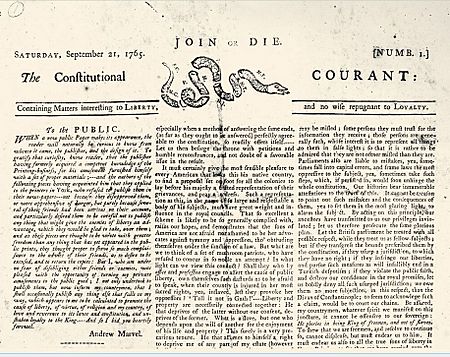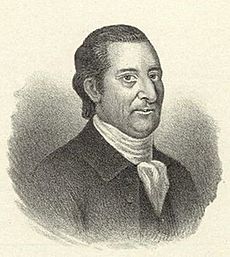The Constitutional Courant facts for kids
The Constitutional Courant was a special newspaper printed in colonial America. It came out in 1765 as a protest against a new British law called the Stamp Act. William Goddard printed it, but he used a fake name, Andrew Marvel. The newspaper strongly criticized the Stamp Act. Its bold message quickly got noticed by other printers and even by British officials. The Courant became very popular. Soon, it was reprinted in other big towns and shared across the American colonies.
Contents
Why the Courant Was Created
In 1765, the British Parliament passed the Stamp Act. This law was meant to help pay off debts from a big war called the Seven Years' War. The Stamp Act put a tax on many paper documents. This included newspapers, contracts, legal papers, and even wills.
Colonists React to the Stamp Act
Most colonists did not like this new tax at all. Newspaper printers and publishers were especially upset. Many of them even stopped printing their newspapers to show their protest. They believed the tax was unfair.
William Goddard's Secret Newspaper
In response to the Stamp Act, William Goddard secretly printed The Constitutional Courant. He printed it in Woodbridge, New Jersey. He used the printing press of James Parker, who had once been Goddard's teacher. Goddard had first asked John Holt to print it, but Holt said no. The Courant quickly caught the attention of both American patriots and the British government.
What the Courant Looked Like
The title of The Constitutional Courant had a special message. It said, "Printed by Andrew Marvel, at the Sign of the Bribe refused, on Constitution-Hill, North America." In the middle of the title was a famous picture of a snake cut into pieces. This snake stood for the colonies, which were not united yet. Below the snake was the motto: "Join or die."
Messages and Mottos
Under the main title, there was a message to the public from the fake printer, Andrew Marvel. The first Courant was printed without a date. But we know it came out on Saturday, September 21, 1765. This was about two months before the Stamp Act was supposed to start. The newspaper's motto was: "Containing matters interesting to Liberty, and nowise repugnant to Loyalty." The Courant was filled with articles that strongly criticized the new tax. These articles showed how angry the colonists were becoming.
How the Courant Spread
The Constitutional Courant was the first newspaper ever printed in New Jersey. People in other colonies really liked its message. The demand for it was so high that it was reprinted in Boston and Philadelphia. It joined other newspapers that were already speaking out against the Stamp Act.
Secret Distribution
Sales of the Courant were unusually high. It was secretly sent to New York City. There, newsboys were hired to sell it on the streets. It was also delivered along all the mail routes by colonial riders. However, New York was a city with many people loyal to Britain. Most newspapers there thought the Courant's articles were too extreme. So, it wasn't widely distributed in New York.
Government Reaction and a Clever Trick
The British colonial government in New York noticed the Courant. Its appearance caused a lot of excitement. A meeting was held at the fort in the city. But they couldn't figure out who wrote or printed the paper. So, they couldn't take any action. One council member asked a newsboy named Lawrence Sweeney, "where that incendiary paper was printed?" Sweeney was ready for this question. He had been told to answer, "At Peter Hassenclever's iron-works, please your honor." Peter Hassenclever was a rich German man known for owning huge iron factories in New Jersey. Later, other protest papers often used the same fake address: "Printed at Peter Hassenclever's iron-works." Only one issue of The Constitutional Courant was ever published. It was never meant to be a regular newspaper.



